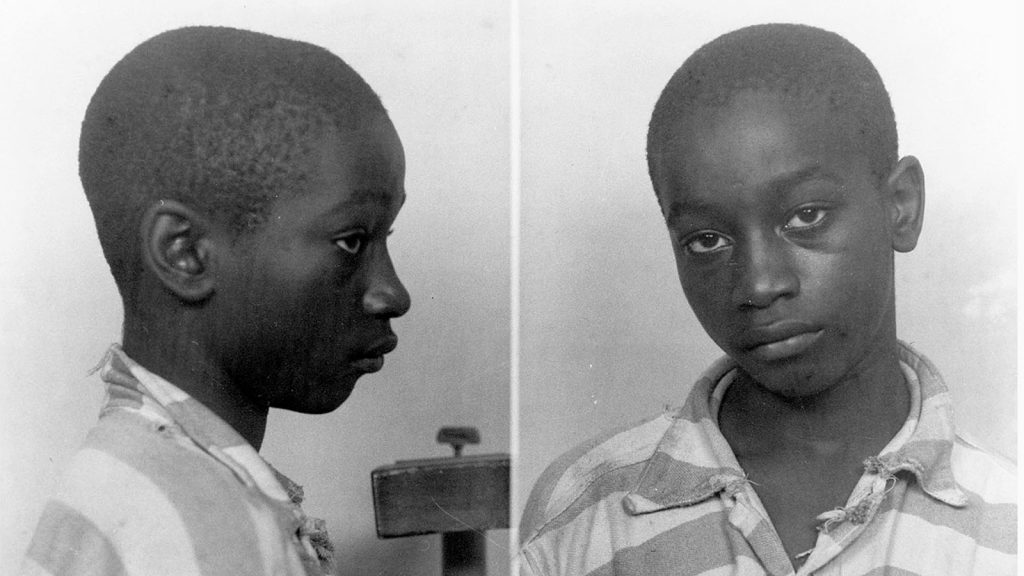
June 16, 1944 was execution day at the Central Correctional Institution in Columbia, and next on the docket to confront the electrical chair was George Stinney, a 14-year-old African American boy from Acolu, South Carolina. George weighed merely 95 pounds and stood at only 5” 1′ at the time he was strapped to an electric chair too big for his physique.1 Due to George’s small physique, extra holes needed to be punched into the chair’s leather bindings before the bindings could fit onto George’s limbs. This extra step bought George a couple extra minutes of life before he faced the electric chair.2 What was 14-year-old George Stinney thinking about right before execution? Surely not that he would soon become the youngest person executed in the 20th century.3

On March 24, 1944, tragedy and injustice came strolling into the small segregated lumber mill town of Alcolu, South Carolina. Betty June Binnicker, 11, and Mary Emma Thames, 7, were walking with their bike when they came across Aime Stinney Ruffner and George Stinney. The girls asked Aime and George whether or not they knew where they could find Maypops. Aime and George responded with a “no” and the girls went on their way. The night of March 24, Betty and Mary were reported missing after both girls failed to return home. The morning after, Betty June Binnicker and Mary Emma Thames were found dead in a ditch with their bikes laying on top of them. Police arrived at the Stinney household and arrested George, a 14-year-old African American boy, for the murders on Betty June Binnicker and Mary Emma Thames.4 Unfortunately, at the time police arrested George, the 1966 Supreme Court ruling on Miranda v. Arizona, which requires law enforcement officials to advise suspects of their rights, had not been ruled yet.5 After the police arrested and interrogated George without any access to his parents nor to an attorney, George confessed to the murders of Betty Binnicker and Mary Thame.6 George Stinney was not the only party impacted as a result of the murders, the Stinney family was persecuted by the rest of the town due the accusation against George. George Stinney Sr. was fired from work and the entire family was forced to permanently leave Acolu and move to Pinewood where the grandmother resided. Aime Stinney Ruffner stated, “We had no choice, the crowd came and they said they were going to get us.”7
The judge presiding over the case appointed Charles Plowden, 31-year-old local lawyer and aspiring politician, to represent George Stinney during the trial. On April 24, 1944, residents of Alcolu packed the local courthouse hoping justice would be served swiftly. A jury composed of 12 white men would be destined to determine George Stinney’s fate.8 Plowden failed to motion for a change of venue, which is a motion to change the location of a trial to overcome local prejudice. Stinney could have had a less partial jury in a different location. The prosecution’s case relied on the testimony of two police officers giving an account of Stinney’s confession he made during his interrogation. According to the police, Stinney confessed to having followed Betty Binnicker and Mary Thames after initially making contact with the girls, then unsuccessfully attempted to rape Betty, and then proceeded to beat both Betty and Mary with a railroad spike that had been laying around. The prosecution presented Stinney’s birth certificate as the last piece of evidence. The prosecution presented the birth certificate to make the case that Stinney was born on October 21, 1921, making him 14 years of age, which was traditionally the accepted age of criminal responsibility at the time.9 Plowden failed to cross-examine the prosecution’s witnesses, call forth any witness that could have corroborated with Stinney’s alibi, question the circumstances under which the police obtained the confession, nor to point out the lack of physical evidence, nor to point out the impracticality of a 14-year-old boy weighing 95 pounds and standing at 5 feet and 1 inch of physically being able to murder two girls, and finally failed to file an appeal. Plowden’s only defense comprised of the defendant being too young to be held responsible for the crimes he committed. Stinney’s trial, that would determine whether he lived or died, lasted a total of 3 hours. The judge sentenced the jury to deliberation, and 10 minutes later the jury comprised of 12 white men, found 14 year old George Stinney guilty of the murders of Betty June Binnicker and Mary Emma Thames. The judge sentenced George Stinney to death by electrocution. On June 16, 1944, the 2,400 volts of electricity passing through George Stinney rendered his body lifeless.10

70 years after the execution of George Stinney, Stinney’s three remaining siblings are seeking justice of their own with the help of a group of lawyers and civil rights advocates determined to exonerate Stinney. Stinney’s prosecution combined unconstitutional errors with serious misconduct. The team of attorneys argued in the Sumter County Courthouse that Stinney’s verdict was solely based on a coerced confession, therefore, the verdict should be thrown out.11 Due to new testimony, Stinney’s family, along with the team of attorneys, are hoping Judge Carmen T. Mullen, of the Fourteenth Circuit Court in South Carolina, rules in their favor. Despite most of the evidence, including Stinney’s confession and the transcript of the trial disappeared, Mullen heard new testimony from Stinney’s brothers and sisters, a witness from the search party, a child forensic psychiatrist, and a statement from Wilford Hunter, Stinney’s former cellmate.12 Frankie Bailey Dyches, the niece of one of the victims, stated, “He (George Stinney) was tried, found guilty by the laws of 1944, which are completely different now—it can’t be compared— and I think that it needs to be left as is.”13 Circuit Judge Carmen Mullen makes an important distinction in the Stinney case by stating that her task is not deciding whether Stinney is guilty or innocent, but rather to decide whether or not Stinney received a fair trial. On December 10, 2014, Circuit Judge Carmen Mullen vacated George Stinney’s conviction. Mullen ruled that Stinney’s confession was likely coerced and therefore inadmissible, “due to the power differential between his position as a 14-year-old black male apprehended and questioned by white, uniformed law enforcement in a small, segregated mill town in South Carolina.”14
George Stinney was tried, convicted of murdering two young White girls, and sentenced to death by electrocution, all in a single afternoon. The story of George Stinney showcases the irreversible actions that occur in a flawed criminal justice system that implements the death penalty primarily against minorities. The court system failed to provide George Stinney with a fair and impartial trial in 1944. As a result, George Stinney paid the ultimate price, death. 70 years after the death of Stinney, the Fourteenth Circuit Court in South Carolina ruled justly by vacating Stinney’s conviction. That moment on June 16, 1944 when 2,400 volts of electricity passed through Stinney’s body, it rendered him lifeless. The death of George Stinney sealed his fate in history as the youngest person executed in the 20th century. The finality of the death penalty by definition continues to risk the loss of innocents’ lives.
Warning: the video linked below is a very realistic, violent, and disturbing set of images of what the suffering and execution must have felt to young George Stinney Jr.
- Elaine Aradillas, Jill Smolowe, Howard Breuer, Michelle Boudin, “A Family’s Quest for Justice Wrongfully Executed,”(People, March, 2014), 73. ↵
- Charles Kelly, “Next Stop, Eternity,” (Life Rich Publishing, April 27, 2016), …. ↵
- Jesse Wegman, “A Boy’s Execution, 70 Years Later,” (New York: New York Times, June, 2014), 8. ↵
- Elaine Aradillas, Jill Smolowe, Howard Breuer, Michelle Boudin, “A Family’s Quest for Justice Wrongfully Executed,”(People, March, 2014), 75. ↵
- Miranda v. Arizona, 384 US 436 (1966). ↵
- Elaine Aradillas, Jill Smolowe, Howard Breuer, Michelle Boudin, “A Family’s Quest for Justice Wrongfully Executed,”(People, March, 2014), 75. ↵
- Elaine Aradillas, Jill Smolowe, Howard Breuer, Michelle Boudin, “A Family’s Quest for Justice Wrongfully Executed,”(People, March, 2014), 74. ↵
- Mark Kantrowitz, “The Killing of George Stinney Jr.,”(Rhode Island: Rhode Island Lawyers Weekly, 2018). ↵
- David Bruck, “Executing Teen Killers Again,” (The Washington Post, September 15, 1985). ↵
- Mark Kantrowitz, “The Killing of George Stinney Jr.,”(Rhode Island: Rhode Island Lawyers Weekly, 2018). ↵
- Jesse Wegman, “George Stinney was Executed at 14,” (New York: New York Times, January 12, 2015), 9. ↵
- Lindsey Beaver, “It took 10 minutes to convict 14-year-old George Stinney Jr. It took 70 years after his execution to exonerate him,” (The Washington Post, December 18, 2014). ↵
- Jesse Wegman, “George Stinney was Executed at 14,” (New York: New York Times, January 12, 2015), 8. ↵
- Brad Knickerbocker, “Executed at Age 14, George Stinney Exonerated 70 Years Later,”(Christian Science Monitor, December, 2014). ↵



97 comments
Caily Torres
This article was sad and portrays how unfair and unjust the legal system was. George Stinney knew that the community he lived in was racist, that no matter what he said or did, the jury was still going to find him guilty. Back then, people of color were wrongfully convicted for actions that they did not do, the system was just looking for someone to blame. I believe that Stinney did not commit the crime of murdering those girls and he died for someone else’s actions.
Juliana Montoya
There were many flaws in the whole investigation and since racism was very prominent throughout this time period the poor child had to confess to something that he did not do. I was very surprised by the way he was so wise even though he knew he did not commit the crime, he knew that no matter what he said or did, he was going to be punished or arrested.
POLENG
Some white people are heartless and racist. This story made me cry. U may rest in peace now, Little Boy. YOU ARE INNOCENT.
Michael Thompson
This is a sad story, that an innocent child unknowingly admitting to murders he didn’t commit, was failed in the system back then. It’s easy to assume that the Miranda rights were made for trials like these, where people, probably more specifically people of color who were blamed for many things back then, could get a fair trial without getting killed or their lives ruined for no reason.
Lorena
Very unfair to George, the sad thing was he had no parents to support him at the time he was on jail, it was quick investigation never had a chance to get an attorney for himself and to depend his right to Express what was really happened .Ashamed to the court,police officer and other people who didn’t believe in him. JUSTICE FOR GEORGE! KARMA FOR THE SERIAL KILLER GO TO HILL!!! I feel sad that this innocent young boy died of wrongful conviction. If there was no death penalty at the time he still alive with his family.
rivers
Lorena he did have parents to support him. They were not allowed to be in his presence.
Alexander Avina
This was a very heartbreaking and horrific story. It is terrible to think about how unjust the judicial system was back then. We still have progress to make for judicial system reform, but we have made progress over the past 75 years. I think this story should act as a call for everyday citizens to look at the society they live in and identify any injustice that is present. This story was written very well and explained this story in a very mature way.
Hannah Hennon
This story is so depressing. It is good that George Stinney’s siblings are seeking justice for their brother. It is so sad that it only took less than a day for a fourteen-year-old boy to be interrogated, tried, and electrocuted. That town should feel ashamed of their actions still to this day if they wrongfully tried that boy. This was an interesting article to read and learn more about.
Jacob Silva
This article is rather upsetting for me to read as this article shines light on how cruel and unfair the United States justice system is, to make decisions concerning someone’s livelihood based on race is wrong. Then there’s the fact that he was just an innocent and young child, yet he was still killed in such a horrific way is simply unforgivable.
Paul Garza
Sadly I am not surprised that this is a true story. This is sort of another Emmet Till story, it’s so sad to think that this was an innocent child that was put to death in such a barbaric way. Crazy that Emmet till and George Stinney were both 14 years old when these wrong convictions arose. Crazy how the justice system really fails at actually bringing justice and protecting the people, the real murderer was allowed to roam around and who knows if he killed again.
Kristina Tijerina
I cannot imagine what George Stinney must have been feeling during the time of his execution. He was a 14-year-old boy being wrongfully convicted of the murder of two girls. It doesn’t even make sense for him to have committed this murder when he was 5’1 and weighing 95 pounds. If he had tried to commit a murder such as this, I’m sure one of the girls could have easily gotten away. Stinney wasn’t even given a fair trial as well, and to be put in the electric chair at such a young age for a crime that wasn’t committed by him is so wrong. Not to mention that his family was forced to leave their home and live elsewhere. Stinney didn’t deserve this kind of poor treatment from the justice system.